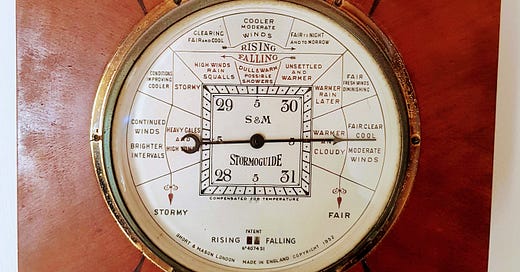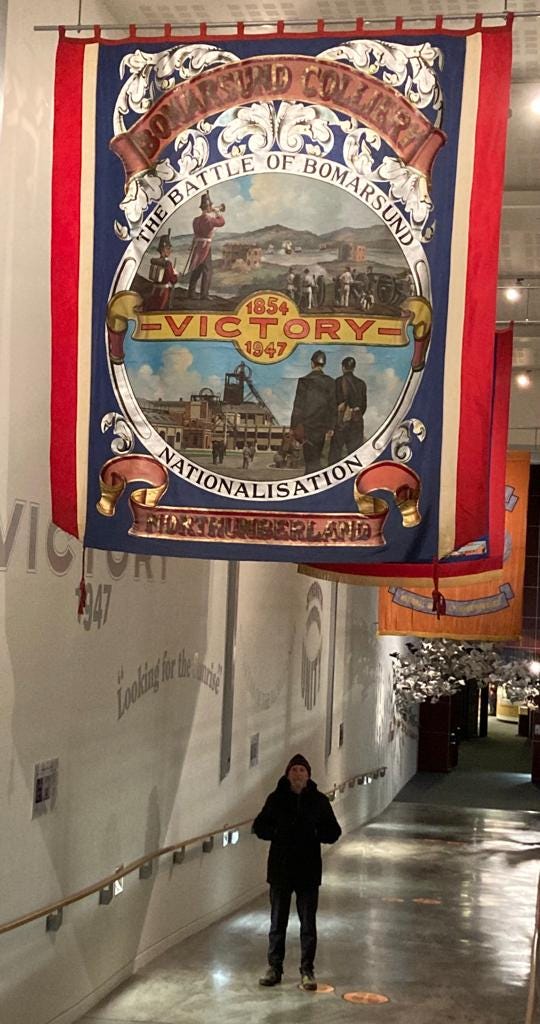He’s late home from work, which is unusual. He’s carrying a brown cardboard parcel, about the size of an old fashioned hat box. There’s excitement in the warm evening air. She smiles tiredly at him; she’s been on her feet all day and she’s eight months pregnant with me. Paddy barks like crazy so he throws his jacket over the dog, which sends him into an even wilder frenzy. (Sometimes he calls the dog Paderewski, after the Polish concert pianist and politician). “What’s in the box Dad?” my sisters shout above the racket. “Aha!” he says, like a conjuror, and carefully places the box on the kitchen table. They look on in anticipation.
The barometer is wrapped in protective layers of tissue paper and when he takes it out of the box, my sisters are puzzled. “What is it Dad?” they ask. “It’s to tell us the weather,” he replies. “Like a clock tells the time, this will tell us the weather.” She stretches out her pale slender arms and gasps a little at its weight. It contains storms, squalls, brighter intervals - and the future. “Look at the inscription,” he says as summer sun lights up the brass plaque.

70 years later, this coeval barometer is on the right of our front door. I inherited it after Mum and Dad passed away. When I was growing up, it was also on the right of the front door and Dad tapped it as he went out and said either ‘Rising’ or ‘Falling’. I do and say the same thing now.
One day, in 1997, I looked more closely at the brass plaque; I was feeling a bit rootless and missed my parents more than I knew. I started to ask myself questions about the barometer’s history: Where is this place Bomarsund? Does the banner still exist? What does it look like? Have I seen it before? I resolved to try and answer these questions and, if I could, find a way back to where I came from.
After many false starts (these were pre-Google days) I discovered that Bomarsund is a tiny place in Northumberland, near Bedlington, and the county archives are stored at Woodhorn Colliery Museum so this seemed like a promising place. I drove there one day and started looking around. These days, the museum is a much bigger affair with a spectacular building and galleries but back then they’d converted some of the old colliery buildings into exhibition areas and restored the winding gear and colliery wheels. In one building, I found some banners on display and a bit of information about them but, frustratingly, could see no sign of the Bomarsund banner.
I decided to ask one of the staff and he said the name ‘Bomarsund’ rang a bell. If I had time, he’d go and check the store room. I had plenty of time. After a few minutes he and a colleague brought out a large object the size and shape of a furled marquee. It took both of them to carry it. They placed it carefully on the floor and rolled it out. Suddenly we saw ghosts in uniform, a battle scene, perhaps an armada, the spirits of miners heading to a pit, their strong backs turned with purpose, a bold VICTORY in the centre and I just knew I’d seen it somewhere and somehow before. My eyes filled with tears and the blokes from the museum knew the importance of what I was seeing so turned away to leave me with the banner. I don’t remember how long I stood there before one of them came over and asked, gently, if I would like to see the other side. I didn’t even know it had two sides but nodded dumbly as they laid it out before me and the room filled with reds, blues, silvers, scrolls, globes, coal, explosions, histories, loss, pride and pleasure that overwhelmed me.
Eventually, it was time to leave and I thanked them effusively for letting me see it. I took some photographs and wondered what to do now my quest was over. One of the blokes mentioned a book being written about Northumberland Colliery Banners and asked if I would like to be put in touch with the author. I left my phone number and a couple of days later Hazel Edwards rang me and we talked about her book. She didn’t know Dad had designed the Bomarsund banner and, although she was going to print in a few days, there was still time to add some information about it if I sent it to her. She told me Dad had also designed the Sleekburn A banner and was including that information in her book but that’s a story for another day.
In her book, Follow the Banner, Hazel describes each side of the banner: ‘Its unusual design was the work of a local man, Mr Don Sutherland, who at the time was a chief electrician for the National Coal Board. The skilfully executed pictures on the front of the banner celebrate a double victory, that of nationalisation in 1947 and Bomarsund in 1854. The Bomarsund Colliery was named after the Russian fortress captured by the British naval force during the Crimean War. News of this significant capture reached Northumberland just as the Barrington Coal Company was laying the foundations of a row of cottages which were to house the men employed to sink the new shaft. To commemorate this naval victory, the sinkers’ row was called Bomarsund.’
‘The reverse of the banner draws a question mark over future sources of power and presents its audience with a stark choice between coal or nuclear power. Set against the backdrop of a globe, perhaps suggesting the global impact of this debate in the 1950s, are two medallions. The first one is a green suburban scene of semi-detached housing with an impressive outcrop of coal on the horizon; next to it is a scene of nuclear devastation.’
David Wray describes colliery banners as follows: ‘Usually measuring between eight feet (2.4 m) high and six feet (1.8 m) wide, the banners are made of silk, and carry images painted on both sides. The size and weight of the banners are such that it requires a team of six to carry each one. The two main carriers each carry a pole that holds the crosspiece from which the banner itself is suspended. The remaining four people hold braided ropes connected to the top of the carrying poles. These are carried fore and aft, at each side of the banner, to provide extra stability, particularly in strong winds.’ (The Place of Imagery in the Transmission of Culture: The Banners of the Durham Coalfield)
This sacred Bomarsund banner flies towards, behind and beyond us. Watch closely as it changes shape; it’s as large as a sail and free as wings. Look how the breeze catches it across time, family and memory. Catches it gently while it sails and floats in and out of focus. Like pressure in air, it’s rising and falling. The wind picks up and ropes tauten like sinews. Hold it tightly. Don’t let go.
Today (27 January) Dad would have been 111. Happy Birthday Dad!







What a beautiful piece of writing. I know that village from my work days but had no idea of its history. It brought tears to my eyes. Well done to you Dad.
Happy Birthday Mr. Sutherland. Lovely banners. The Empire and the Workers - such different times